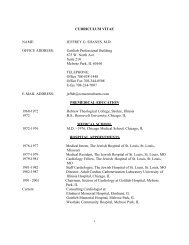Triglycerides: A useful definition
Triglycerides: A useful definition
Triglycerides: A useful definition
Create successful ePaper yourself
Turn your PDF publications into a flip-book with our unique Google optimized e-Paper software.
A triglyceride (triacylglycerol, TAG, or triacylglyceride) is an ester derived<br />
from glycerol and three fatty acids. [1] It is the main constituent of vegetable oil<br />
and animal fats. [2]<br />
Chemical structure<br />
<strong>Triglycerides</strong> are formed by combining glycerol with three molecules of fatty acid. The<br />
glycerol molecule has three hydroxyl (HO-) groups. Each fatty acid has a carboxyl group<br />
(COOH). In triglycerides, the hydroxyl groups of the glycerol join the carboxyl groups of<br />
the fatty acid to form ester bonds [citation needed] :<br />
HOCH 2 CH(OH)CH 2 OH + RCO 2 H + R'CO 2 H + R''CO 2 H →<br />
RCO 2 CH 2 CH(O 2 CR')CR'' + H 2 O<br />
The three fatty acids (RCO 2 H, R'CO 2 H, R''CO 2 H in the above equation) are usually<br />
different, but many kinds of triglycerides are known. The chain lengths of the fatty acids<br />
in naturally occurring triglycerides vary, but most contain 16, 18, or 20 carbon atoms.<br />
Natural fatty acids found in plants and animals are typically composed of only even<br />
numbers of carbon atoms, reflecting the pathway for their biosynthesis from the twocarbon<br />
building-block acetyl CoA. Bacteria, however, possess the ability to synthesise<br />
odd- and branched-chain fatty acids. As a result, ruminant animal fat contains oddnumbered<br />
fatty acids, such as 15, due to the action of bacteria in the rumen. Many fatty<br />
acids are unsaturated, some are polyunsaturated, e.g., those derived from linoleic<br />
[citation needed]<br />
acid.<br />
Most natural fats contain a complex mixture of individual triglycerides. Because of this,<br />
they melt over a broad range of temperatures. Cocoa butter is unusual in that it is<br />
composed of only a few triglycerides, derived from palmitic, oleic, and stearic<br />
acids.{{Citation needed|date=October 2011)<br />
Metabolism<br />
The enzyme pancreatic lipase acts at the ester bond, hydrolysing the bond and "releasing"<br />
the fatty acid. In triglyceride form, lipids cannot be absorbed by the duodenum. Fatty<br />
acids, monoglycerides (one glycerol, one fatty acid), and some diglycerides are absorbed<br />
by the duodenum, once the triglycerides have been broken down.<br />
See also: fatty acid metabolism<br />
<strong>Triglycerides</strong>, as major components of very-low-density lipoprotein (VLDL) and<br />
chylomicrons, play an important role in metabolism as energy sources and transporters of<br />
dietary fat. They contain more than twice as much energy (9 kcal/g or 38 kJ/g ) as<br />
carbohydrates and proteins. In the intestine, triglycerides are split into monoacylglycerol<br />
and free fatty acids in a process called lipolysis, with the secretion of lipases and bile,
which are subsequently moved to absorptive enterocytes, cells lining the intestines. The<br />
triglycerides are rebuilt in the enterocytes from their fragments and packaged together<br />
with cholesterol and proteins to form chylomicrons. These are excreted from the cells and<br />
collected by the lymph system and transported to the large vessels near the heart before<br />
being mixed into the blood. Various tissues can capture the chylomicrons, releasing the<br />
triglycerides to be used as a source of energy. Fat and liver cells can synthesize and store<br />
triglycerides. When the body requires fatty acids as an energy source, the hormone<br />
glucagon signals the breakdown of the triglycerides by hormone-sensitive lipase to<br />
release free fatty acids. As the brain cannot utilize fatty acids as an energy source (unless<br />
converted to a ketone), the glycerol component of triglycerides can be converted into<br />
glucose, via glycolysis by conversion into Dihydroxyacetone phosphate and then into<br />
Glyceraldehyde 3-phosphate, for brain fuel when it is broken down. Fat cells may also be<br />
broken down for that reason, if the brain's needs ever outweigh the body's.<br />
<strong>Triglycerides</strong> cannot pass through cell membranes freely. Special enzymes on the walls<br />
of blood vessels called lipoprotein lipases must break down triglycerides into free fatty<br />
acids and glycerol. Fatty acids can then be taken up by cells via the fatty acid transporter<br />
(FAT).



